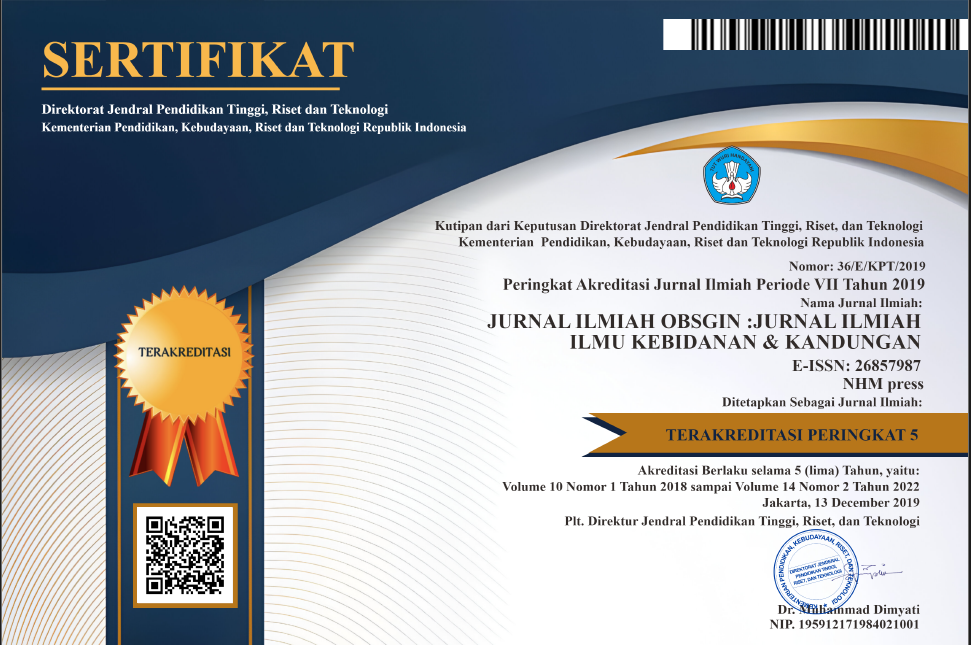HUBUNGAN LAMANYA PEMAKAIAN KB SUNTIK TIGA BULAN DENGAN KEMBALINYA TINGKAT KESUBURAN AKSEPTOR SUNTIK TIGA BULAN DI KLINIK MUHAMMADIYAH LUMAJANG
Abstract
Contraceptive injections are a way to prevent pregnancy by means of hormonal injections given intramuscularly in the buttocks. The three-month contraceptive injection is a type of injectable contraceptive that only contains progestin which is injected once every three months. At the Lumajang Muhammadiyah Clinic, there were 136 users of injectable contraception as of March 2023. This type of injectable contraception has several drawbacks, one of which is the delay in the return of fertility after stopping the injectable contraception. The purpose of this study was to determine the relationship between the duration of three-month injection contraceptive use and the return of fertility in three-month injection acceptors at the Muhammadiyah Lumajang Clinic in 2023. The research method was correlative descriptive with a cross-sectional design. The sampling method was carried out by purposive samplin gwith a population of 45 people and a sample of 25 people was obtained. Analysis of research data isthe univariate analysis and bivariate analysis with the Chi-Square test. The results of the study obtained statistical test results with a P value = 0.000. The conclusion of this study shows that there is a correlation between the duration of using three months of injection contraception and the return of fertility rates to three-month injection acceptors at the Lumajang Muhammadiyah Clinic in 2023. It is suggested that users of hormonal contraception for more than 1 year or long term are advised not to use it in the long term and if you want to use long-term contraception, it is recommended to use non-hormonal contraception.
References
BKKBN. (2019). Konsep Dasar Kontrasepsi. Retrieved March 29, 2019,fromhttp://riau.bkkbn.go.id/ViewArtikel.aspx?ArtikelID=1109
Badan Pusat Statistik (BPS). (2021). BPS: 270,20 juta Penduduk Indonesia Hasil SP 2020. 12 Mei 2021.https://www.bps.g o.id/news/2021/01/21/405/bps--270-20-juta-penduduk-indonesia-hasil-sp2020.html
Darmawati dan Farina. (2017). Pemilihan Alat Kontrasepsi pada Wanita Pekerja di Wilayah Kota Banda Aceh. Jurnal Ilmiah Mahasiswa Fakultas Keperawatan. Vol. 2, No. 3. Pp. 1-7
Everett Suzanre. (2018). Severe Sepsis and Septic Shock. Harison’s: Principles of Internal Medicine 17th Ed. USA: The McGraw Hill Companies; (2015). Ebook version
Hartanto H. (2019). Keluarga berencana dan kontrasepsi. Jakarta: Pustaka Sinar Harapan, hal 102-103.
Izza, K. (bagusizza@yahoo.co.id). 13 Juli 2016. Perbedaan Waktu Terjadinya Kehamilan Pada Ibu Pasca Menggunakan Kb Suntik 1 Dan 3 Bulan Di Puskesmas Bangsal Mojokerto. kepada Kiki Manzilatul Zahroh (kiki.zahroh@yahoo.co.id)
Kepmenkes. (2017). Buletin jendela data dan informasi kesehatan.Vol. 2 Semester 2. Jakarta.
Notoatmodjo, S. (2018). Metodologi Penelitian Kesehatan. Jakarata. Rineka Cipta.
Nugroho, T dan Utama I.B. (2014). Masalah Kesehatan Reproduksi Wanita. Yogyakarta: Nuha Medika
Saifuddin, A. B. (2018). .Buku Panduan Praktis Pelayanan Kontrasepsi. Jakarta : Yayasan Bina Pustaka.
Sugiyono. (2017). Metode Penelitian Kuantitatif, Kualitatif dan R&D. Alfabeta:Bandung, hal 135-138.
Sunardi. (2017) . Ilmu Kebidanan . YBP-SP. Jakarta, hal 76-77.
Studi kualitatif kabupaten Lumajang. (2018). Riset operasional advokasi keluarga berencana untuk meningkatkan metode ragam kontrasepsi. Jawa Timur.
Saifuddin, A. B. (2013). :“Kontrasepsi suntikan progestin”. In Biran A., Baharuddin M., Soekir S. (Ed). Buku panduan praktis pelayanan kontrasepsi.. Jakarta:Yayasan Bina Pustaka Sarwono Prawirohardjo Edisi ke 2.











